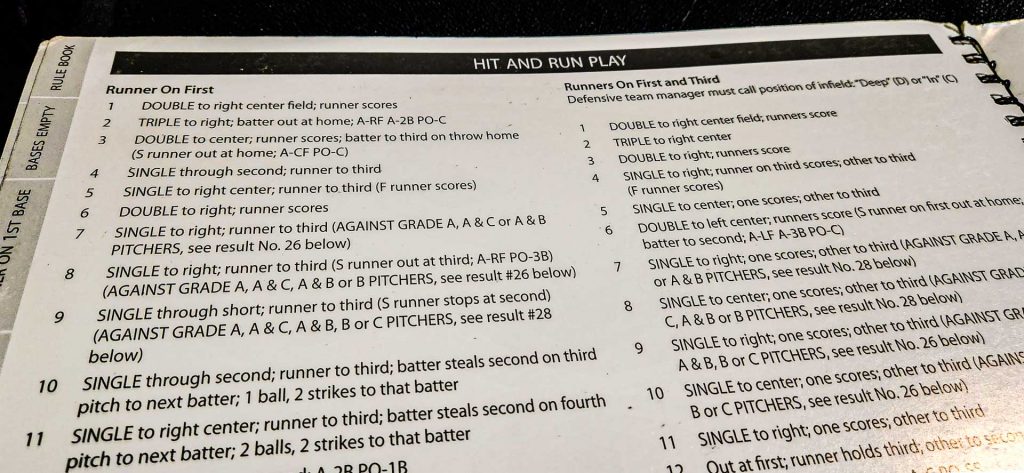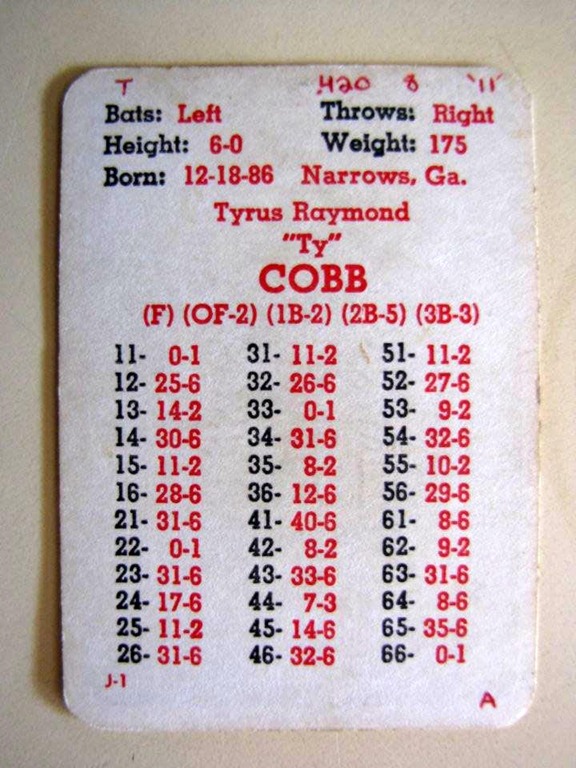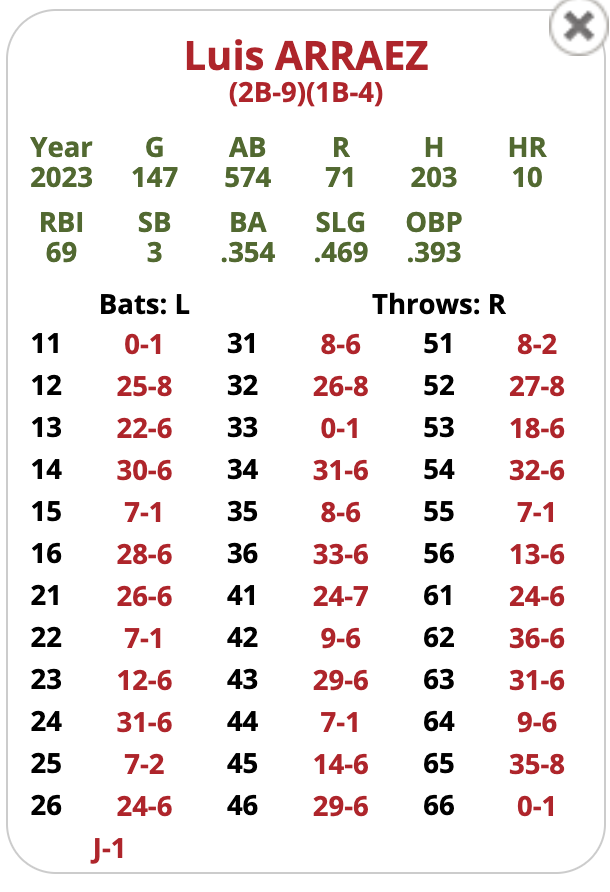After writing up Craig Biggio’s Monster Card piece last week, I got to thinking that there really should be a good guide on APBA Baseball’s hit & run. There are so many misconceptions about it and how it should be used. Who should we hit and run with and who should we NOT hit and run with?
Before I get started, I will be strictly referring to the results from APBA’s newer booklet (published in 2013). Like most fans, I resisted the change to the change in the H&R charts but over time, I realized the older ones were too offense-heavy.
What is the hit and run play?
I’m sure most of you are familiar with the hit and run play. It’s simple. On the pitch, a runner on first base will break for second and the batter will swing with the intention of putting the ball in play.
The perfect scenario is for the batter to hit the ball through the hole caused by the fielder covering second. A ground ball will most likely result in moving the runner along. If the ball is not hit, it will result in a steal attempt.
That’s a barebones outline of the play. Baseball Reference has a full definition of the strategy.
Advantages for using APBA’s Hit and Run charts
There are a few good reasons to call the hit and run play, obviously. Here are a few.
- I’ll start with the obvious. Play result 31 is always a hit.
- Almost all ground outs (play result numbers 26, 28, 29 etc.) move the runner(s) along.
- Especially important, usual double play numbers like 24 and 12, also move the runner along.
- A play result 14 will result in a steal as long as the baserunner has a first column 11 (this is helpful against pitchers with a Z rating).
A bit of trivia: a 12-25 while calling a hit and run with runners on first and third, is the only time that will actually provide a somewhat positive result (D-Out at first; runners advance one base; A-2B PO-1B)
Disadvantages for using APBA’s Hit and Run charts
There are a lot of reasons not to hit and run which is why it’s important to pick and choose when to call it.
- Many extra base play result numbers are changed. Most notably, a 1 is no longer a homerun. It is a double.
- Play result 13 and 14 result in the baserunner getting caught stealing. As I mentioned before, the runner steals successfully if he has an 11 but that is only with a runner on first. With a runner on first and third, he is out.
- Lineouts (play result numbers 33 and 34) are double plays. So is 32 with runners on first and third.
- Be aware when using the H&R against B pitchers as play result number 9 will NOT be a hit (9–SINGLE thru short; runner to third (S runner stops at 2nd)(AGAINST GRADE A, A&C, A&B, B or C PITCHERS use result No. 28 below)
Runners on first and third. Worth it?
Keep in mind that the H&R First and Third chart contains some changes from Runner on First. Even with the nifty 25 result, it is a bit more limiting. I’ve already mentioned the 32 double play but if your card has a 41, that’s a 5-3 triple play.
It’s a little random if you’re able to move things along with runners on first and third. Sometimes, both runners move on ground balls and sometimes just the runner on first will move up.
Also worth mentioning, a runner’s chance of stealing is quite limited with runners on first and third. A play result 14 results in a caught stealing. Also, result 35 which is a steal for runners with a 10 or an 11 on their card on the Runner on First chart, is simply a foul out on this chart. To top it off, a play result number 11 doesn’t even net you a steal for the batter.
Many of the usual power numbers 1-6 have slightly unusual results. Take play result number 5 with a runner on first. It’s a single. But wait! The runner will score if he is rated fast.
What is the best type of card to hit and run with?
It’s easy to say that APBA cards with three or more 31s are great to with the hit and run. And that’s true… to a point. There’s more to it though.
Last week’s Monster Card 1997 Craig Biggio has three 31s. And yeah, he would okay but not perfect. Ideally, you would want someone with a little more bat control.
I’m looking for a hitter with extra ground ball numbers like 26 and 28. Also, I would want as few 13s as possible. If you look at some deadball cards, like 1911 Ty Cobb to the left, you can see they are geared for the hit and run.
Looking at current MLB, it’s hard to players to fit the bill as a true hit-and-run style hitter. I’m going on memory but Luis Arraez comes the closest in my mind. A contact hitter, few strikeouts, and a side benefit is that he won’t get that pesky 1 that will be downgraded to a double.
Maybe I’ll post that card and we’ll see how close I am.
Needless to say, it is very important to have a baserunner on first base with a first column 11. If not result numbers 14 or 35 will end in him getting caught at second.
The H&R plays a role given the era
That all said, the hit and run strategy plays an important role in APBA. Those who play deadball replays or take deadball teams to tournaments know what I’m talking about. The H&R play is integral in that era.
I played a few deadball teams at the Chicagoland APBA Tournament and each manager implemented the hit and run to success. Unfortunately for me, it worked very well.
Does The APBA Blog use the H&R play?
I asked TAB contributor Bob Gordon on his opinion of APBA’s hit and run and if he ever called it in league play or in his replays. Apparently, he isn’t a big user of the strategy.
I do not (use it). With the old boards, I would use the hit and run occasionally. If I knew a guy was a good hit and run guy (multiple 31s) and had a decent runner ahead of him, I’d hit and run. Or if my team was struggling to get base runners, I would use it out of desperation.
I seldom get a roll that results in a 1, but I can guarantee that with the new boards, if I called a hit and run, I would get a one result and my dinger knocked down to a single. The risk reward leans way towards risk.
As for me, I may have used it a handful of times so far through 87 games in the Illowa APBA League. While the current baseball era doesn’t lend itself to the H&R strategy, my team actually has plenty of speedsters such as Elly de la Cruz and Whit Merrifield. On occasion, if one of them finds their way on first base and someone with good bat control is up, I may try it like Bob says, out of desperation. Just to move the runner along would be preferable.
I don’t use the hit and run with runners on first and third. Too many downsides in my opinion. I also don’t like using the strategy with two outs. Since a big part of it is to move the runner along, that is taken away.
Do you use APBA’s hit and run charts? Does it work well for you? Let me know!







I’m replaying 1970 NL (slowly!). I’ll use it with batters who have three 31s, and with batters who have two 31s and a lot of 24s – to stay out of the DP. With the old boards in leagues where winning was everything, we would hit and run with batters who had lots of 13s and 14s and a runner on 1st because you would get a free stolen base. We were kids then…glad they cleaned it up.
Hi Jesse,
I remember those old charts. We had one manager who would h&r with sluggers with lots of 13s to get the steals too. :)
I like your quote: “We were kids then”. ;)
While I agree with the changes made to be more in line with baseball strategy as of 2024, I really miss the “old charts”.
While I was still in the league I did a test on the hit and run chart. I used Francisco Lindor as my test subject. His card had a 15-11 and a 45 14*. For his in league season I did not use the hit and run at all.
I was at the time doing my 2015 replay, so the cards were all from the same time frame and using the same charts. In my replay I would use the hit and run on players with an 11 on base.
When both the replay and league season were over I compared the results. I don’t remember the “exact” numbers, but Lindor was off by one on steals for the season, and for the replay, about 35% of the runners made their number, with 2 or 3 exceeding it by 2-3 steals, but the rest failed to reach their number, with about 3 or 4 far below the number.
This was usually the result of batters behind these runners with lots of 13’s, and I do remember an unusually high number of 34’s being the result and innings ruined from a double play.
So as a result I never use the current hit and run. EVER. There is almost nothing to be gained by it. Using hit and run with runners on the corners is basically asking “may I please have my runner thrown out?”.
But APBA has made the charts reflect real world strategy, in which the hit and run is almost a forgotten tool.
Nice conversation, Gents.
Perhaps it depends on the APBA player’s intent? If one is playing to win a game, say in a tournament, then there are drawbacks noted by “Scott”. But, if one is using APBA to replicate baseball, then the HnR play offers more than just the PRN-31 result.
Personally, I use the HnR when cautioned base-stealers are on 1st, but adept contact hitters at bat (this accomplished by rating each player per their SB% v. the hitter’s K% & IP%). The LAST thing I’m considering is the number of PRN-31s on a tablet.
Most often, one gets the benefit of staying clear of the DP, advancing the runner (almost tactically replacing the dreaded SH) while RETAINING a chance of a hit – which is tactical bonus.
It is good they changed it. I could not resist with an expansion team I had Larry Lintz and one of Schmidt’s first cards. I remember Schmidt had a million strikeouts on a modest card, but boy did Lintz run with Schmitty up. It was very ridiculous but….entertaining.
I still use the old Sacrifice/Hit and Run Book I refuse to acknowledge the existence of the new boards.
I am working on a 1908 using the basic game with the updated boards. I like the updated boards overall. The hit and run with a runner on first and a busted hit and run play the catcher has a little better chance of throwing out the runner. With the pitching as dominant as it was, I use the hit and run to move runners along and to stay out of double plays. There are some games I do not use it all. Willie Keeler who was near the end of his career has 4 31’s on his card. A player who had tremendous bat control. I very rarely use hit and run with runners on first and third.
Hi Andy,
that’s good input from a deadball perspective. I agree about first and third. Perhaps it is a tad strict?
The main reason I rarely use hit and run with runners is when call it seems I keep turning hits into outs or double plays. The other strategy I use with abundance of A and A&C pitchers is to use the sacrifice when the there a runner on second or first and second with no outs. By doing so you turn any 8 hit number into base hits rather than out. The strategy does fail every so often when dice roll is 66 and turn a hit into an out
Probably the best APBA hit and run combination were Louie Aparicio and Nellie Fox on the mid fifties to early sixties. Louie Aparico almost always led the league in steels, so he always had an 11, while Fox had between three and five 31s. It also corresponded to their real life results. They weren’t called the “Go Go Sox” for nothing. They were the very first team I followed.